
Capillary Tubes
Capillary tubes, despite their small size, play a pivotal role in various industries, showcasing an impressive blend of precision and versatility. These slender tubes, with their narrow internal diameter, have found their way into numerous applications, quietly becoming essential in various fields. In this exploration, we will delve into the world of capillary tubes, unraveling their significance and shedding light on the myriad ways they contribute to the seamless functioning of industries, ranging from refrigeration to healthcare. Join us on this journey to understand how these unassuming tubes have become indispensable components across the industrial landscape.
What are Capilary tubes?
Capillary tubes are slender, small-sized tubes characterized by their narrow internal diameter. These tubes, often overlooked due to their size, play a crucial role in numerous industrial applications, providing precision in fluid control and transfer.
Materials
Manufacturers commonly use various materials to craft capillary tubes, tailoring them to specific applications. These materials include glass, metals, and plastics. Glass capillary tubes are preferred in laboratory settings for their transparency and chemical resistance, while metal capillary tubes find applications in areas requiring durability and resistance to high temperatures. Plastic capillary tubes, on the other hand, offer flexibility and corrosion resistance, making them suitable for diverse uses.
Size Variations
Capillary tubes come in a diverse range of sizes, each serving specific purposes in different industries. The internal diameter of these tubes can vary significantly, impacting their functionality. Ranging from microscopic dimensions to larger sizes, the diversity in capillary tube sizes allows for precise customization according to the requirements of various applications. The diameter of the capillary tube is a critical factor, influencing aspects such as fluid flow rates and the overall efficiency of the system in which they are employed. This adaptability in size ensures that capillary tubes find utility in an extensive array of settings, from delicate laboratory experiments to robust industrial processes.
Usages of Capilary Tubes
Refrigeration and Air Conditioning: Capillary tubes serve as vital components in refrigeration and air conditioning systems, where precise control of refrigerant flow is paramount. These tubes, often located near the evaporator coils, regulate the amount of refrigerant entering the coils, facilitating the cooling process. The narrow diameter of capillary tubes ensures a controlled flow rate, contributing to the efficiency and functionality of the overall refrigeration or air conditioning unit.
Medical Applications: In the realm of healthcare, capillary tubes find essential applications in medical instruments and devices, particularly in blood glucose meters. These miniature tubes assist in drawing and measuring small, precise volumes of blood, crucial for accurate glucose level readings. The use of capillary tubes in such medical devices underscores their role in enabling precise and efficient diagnostic procedures.
Laboratory Equipment: Capillary tubes play a significant role in laboratory equipment, notably in chromatography systems. In techniques like gas chromatography and liquid chromatography, these tubes facilitate the separation of components within a sample. The narrow diameter of the capillary tubes ensures high resolution and efficiency in separating different compounds, making them indispensable in analytical and research laboratories.
Industrial Processes: Across various industrial processes, capillary tubes are employed for precise fluid control. Whether in chemical manufacturing, food processing, or automotive applications, these tubes contribute to maintaining exact fluid volumes and flow rates. Their role in industrial settings extends to diverse processes such as dosing, mixing, and dispensing, where accuracy and reliability are paramount. The ability of capillary tubes to handle a wide range of fluids makes them versatile tools in optimizing industrial operations.
Application of Capillary tubes
Heat Exchangers: Capillary tubes play a crucial role in heat exchangers, serving as conduits for transferring heat between fluids. The precision and small diameter of capillary tubes enable efficient heat exchange, making them valuable components in systems ranging from HVAC units to industrial processes. By facilitating the controlled movement of fluids, capillary tubes contribute to the optimal thermal performance of heat exchangers.
Fluid Dynamics: In the realm of fluid dynamics, capillary tubes find application in small-scale experiments to study fluid behavior. Their narrow dimensions allow researchers to observe and analyze fluid flow in a controlled environment. Capillary tubes are particularly useful in investigating phenomena such as capillary action, surface tension, and fluid movement in microfluidic systems. The versatility of capillary tubes makes them invaluable tools for advancing our understanding of fluid dynamics on a miniature scale.
Electronics: Capillary tubes are employed in electronic devices, playing a crucial role in cooling and thermal management. The compact size and thermal conductivity of these tubes make them ideal for dissipating heat generated by electronic components. In applications such as LED lighting, lasers, and electronic sensors, capillary tubes contribute to maintaining optimal operating temperatures, ensuring the longevity and efficiency of electronic systems.
Chemical Analysis: Capillary tubes find a niche in chemical analysis techniques, notably in capillary electrophoresis. In this method, the tubes are utilized to separate and analyze charged particles, such as ions and molecules, based on their electrophoretic mobility. The high resolution and efficiency of capillary electrophoresis make it a powerful tool in various fields, including biochemistry, environmental analysis, and pharmaceutical research. Capillary tubes, with their precise dimensions, enhance the accuracy and sensitivity of these chemical analyses.
Deatils of Capilary Tubes. Advntages & Disadvantages
Manufacturing Process: Capillary tubes undergo a meticulous manufacturing process that emphasizes precision to meet the stringent requirements of diverse applications. The process typically involves drawing or extruding materials, such as glass, metals, or plastics, to achieve the desired diameter and length. The material is carefully selected based on the specific application requirements, ensuring compatibility with the intended use. Quality control measures are implemented throughout the manufacturing process to guarantee the precision and reliability of the final product.
Maintenance: To ensure optimal performance and longevity of capillary tubes, proper maintenance practices are crucial. Here are some tips for maintaining and handling capillary tubes:
- Cleaning: Regularly clean capillary tubes to remove any debris or residue that may affect their performance.
- Avoiding Contamination: Handle capillary tubes with clean hands or wear gloves to prevent contamination, especially in applications where purity is critical, such as in laboratory settings.
- Storage: Store capillary tubes in a controlled environment, protecting them from extreme temperatures and humidity to prevent material degradation.
- Inspecting for Damage: Periodically inspect capillary tubes for any signs of damage, such as cracks or bends, and replace them if necessary to maintain accuracy in fluid control.
Advantages and Disadvantages od Capillary tubes
- Precision: Capillary tubes offer precise control over fluid flow, making them suitable for applications requiring accurate measurements.
- Versatility: The diverse range of materials and sizes available makes capillary tubes versatile, adapting to various industries and applications.
- Efficiency: In applications like heat exchangers and fluid dynamics experiments, capillary tubes contribute to efficient heat transfer and fluid studies.
- Clogging Risk: Due to their small diameter, capillary tubes are susceptible to clogging, especially when dealing with fluids that may contain particles or impurities.
- Fragility: Depending on the material, capillary tubes can be fragile and prone to breakage if mishandled or exposed to excessive force.
- Limited Flow Rates: The narrow diameter of capillary tubes can limit the flow rates of fluids, potentially impacting the speed of certain processes.
FAQs Related to Capillary tubes
Q1: What is the primary function of capillary tubes?
- A1: Capillary tubes are primarily used to control the flow of fluids, especially in applications where precision and small-scale fluid dynamics are essential. They find extensive use in areas such as refrigeration, medical instruments, and laboratory equipment.
Q2: What are the materials commonly used to make capillary tubes?
- A2: Capillary tubes are made from various materials, including glass, metals (such as copper or stainless steel), and plastics. The choice of material depends on the specific requirements of the application.
Q3: How are capillary tubes used in refrigeration and air conditioning?
- A3: In refrigeration and air conditioning systems, capillary tubes serve as throttling devices. They control the flow of refrigerants, allowing for the efficient transfer of heat and facilitating the cooling process.
Q4: Can you explain their role in laboratory equipment?
- A4: Capillary tubes are commonly used in laboratory equipment, particularly in techniques like chromatography. They assist in the separation and analysis of different components in a sample based on their interactions with the capillary material.
Q5: Are capillary tubes used in medical devices?
- A5: Yes, capillary tubes play a crucial role in medical instruments, especially in devices like blood glucose meters. They help in precise measurement and handling of small fluid samples.
Q6: How are capillary tubes manufactured?
- A6: Capillary tubes are manufactured through processes that involve drawing or extrusion. The chosen material is shaped into tubes with precise internal diameters to meet the required specifications for different applications.
Q7: What are the advantages of using capillary tubes?
- A7: Capillary tubes offer advantages such as precise fluid control, suitability for small-scale applications, and compatibility with various materials. They are also cost-effective and find use in a wide range of industries.
Q8: Are there any disadvantages to using capillary tubes?
- A8: While capillary tubes are versatile, they may have limitations in handling high flow rates due to their narrow diameter. Additionally, they can be susceptible to clogging in certain applications.
Q9: How should capillary tubes be maintained?
- A9: Proper handling and maintenance are crucial. Avoid bending or damaging the tubes, and follow manufacturer guidelines. Regular cleaning may be necessary in applications prone to clogging.
Q10: Where else are capillary tubes commonly used?
- A10: Capillary tubes are also widely used in heat exchangers, electronic devices for thermal management, fluid dynamics experiments, and various industrial processes that require precision fluid control.
